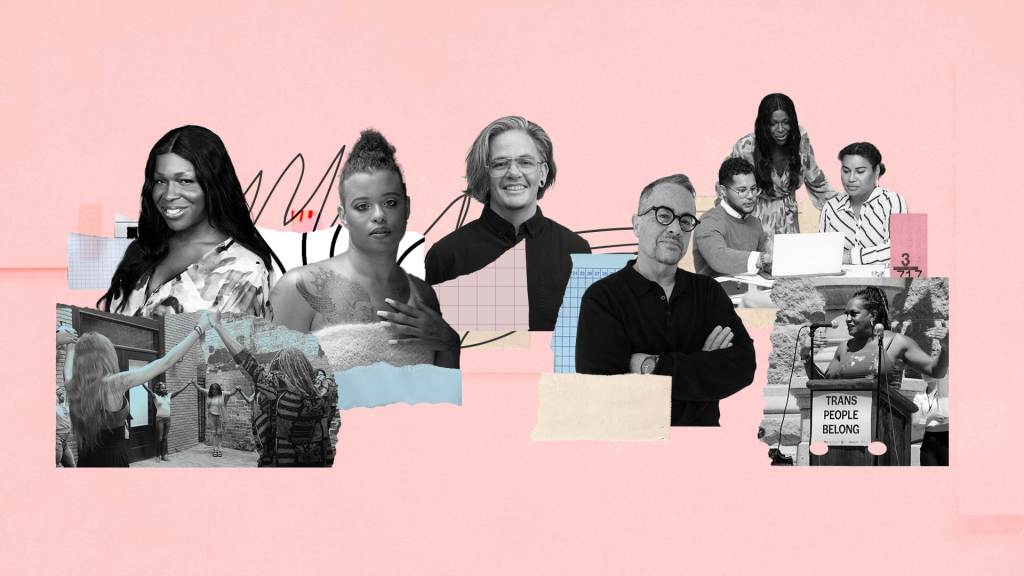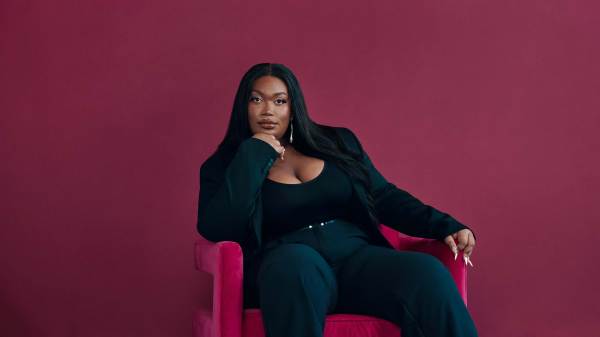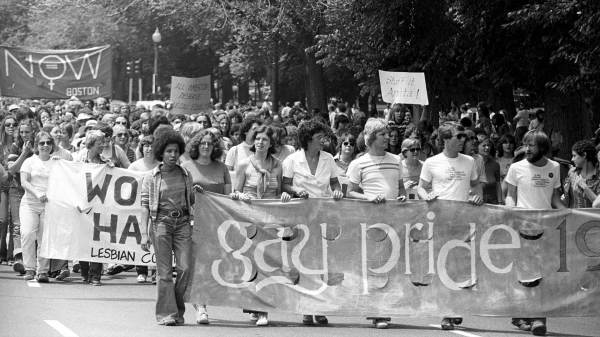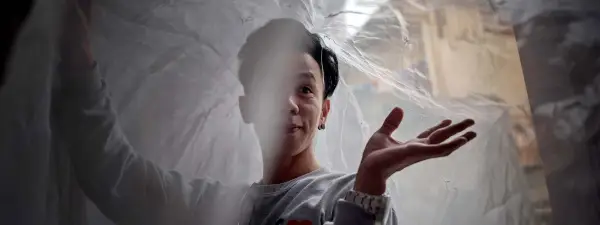
Celebrating history and community across generations
Nearly a quarter of a century ago, Navy veteran and American trans woman Monica Helms created the bright, beautiful transgender Pride flag. She gave it three signature colors—light blue as the traditional color to represent baby boys, light pink to represent baby girls, and a white stripe in the middle to represent those who are transitioning, non-binary, or intersex. The flag, which is now carried at marches and festive events around the world, was designed to always look the same. “The pattern,” Helms once explained, “is such that no matter which way you fly it, it will always be correct. This symbolizes us trying to find correctness in our own lives.”
This March 31, which marks International Transgender Day of Visibility, trans people around the world have many reasons to celebrate and wave the flag Helms created in 1999. They are making history at the Olympics and garnering Grammys. They are being elected to office in the United States. They are securing the right to list the gender they identify as on their official IDs in Hong Kong and Spain.
At the same time, trans people around the world are contending with a cancerous and quickly growing backlash that threatens their safety and very existence. The situation is particularly dire for Black trans women who exist at the intersection of three identities—they’re Black, transgender, and women—that renders them especially vulnerable to violence that sometimes turns fatal.
It is this grave situation—not trans people themselves—that must be urgently rectified. Trans people have existed for centuries, with cultures around the world long recognizing and accepting gender fluidity and nonconformity. They are here to stay, and their fight for bodily autonomy is interconnected with and inseparable from the movements for reproductive justice, abortion access, racial justice, disability justice, and immigrant rights.
We believe that everyone should celebrate Trans Day of Visibility, and we encourage allies and advocates as they push for an acceptance of all people. We also understand how daunting life is for trans people today. While they yearn for increased visibility on this day—and every day, in their schools, workplaces, and communities—many fear that living their truth can threaten their very being. How can trans people not just survive but also thrive when they are routinely subjected to threats?
To better understand how to navigate this reality, remain hopeful, and honor Trans Day of Visibility, we spoke to four venerable trans leaders. Shelby Chestnut of Transgender Law Center, Morey Riordan and Aryah Lester of Transgender Strategy Center, and filmmaker and Disability Futures fellow Tourmaline provide much needed words of wisdom.

Shelby Chestnut, executive director, Transgender Law Center
What does Trans Day of Visibility mean to you?
I see it as a day of reflection, and a moment of intentional celebration of the lives, leadership, and victories of trans people. To honor the elders who came before us and figure out how to carry on their legacies. This seems especially important as young trans people are currently under attack. How can we create that intergenerational connection in our community?
So, today is celebratory, but it is also a day to pause and think about how to change people’s lives in big and small ways. At TLC, we care about telling stories that share our strength and our hope. Trans people are an important part of our society’s fabric, and that’s something for everyone to celebrate. We should all be working to create a world that is more equitable than the one we inherited.
What does a safe, just, and equitable future look like for trans people?
A safe, just, and equitable future for trans people means that we are celebrated and also seen as community leaders. It means an end to the policies that aim to eradicate us. Trans people have always been a part of history, but we are currently facing a wave of forces that wants to dehumanize and criminalize us—just for existing.
In the future, I’d like to think that trans people won’t have to fight for and defend our fundamental human rights and dignity. I’d like to see a world where transgender people, especially kids and their families, can take ordinary things for granted. I want them to be safe at school. I want the doctor to listen to them. I want them to be able to disclose their identity, without worrying that it will impact their survival.

“We should all be working to create a world that is more equitable than the one we inherited.”
Shelby Chestnut, executive director, Transgender Law Center
A few years ago, I met a young girl and her very supportive parents at a trans-focused community event. My name tag said “TLC,” and the little girl was so excited thinking that I worked for The Learning Channel. It was difficult, but I had to break it to her that I did not in fact work with dinosaurs! In that moment, I wish we lived in a world where young trans kids could just be kids focusing their joy on childhood things.
What is your message to trans people, especially trans youth, looking for hope and joy today?
That’s a hard question given the world today, but I would say, you’re important, and we’re with you. We will do everything in our power to not only ensure that you’re alive, but thriving. You are a leader in your own life and community, and we defer to your expertise. I recognize that you are being attacked but still finding moments to celebrate.
Not all hope is lost. Trans people are valuable, have our place in this world, and there are so many people working to make sure that we are safe, celebrated, and respected. A few weeks ago, the largest gathering of trans people and allies assembled at Texas’s State Capitol. It was representative of the state’s demographics, both racially and ethnically, as well as generationally. Families showed up to support trans kids and loved ones. That’s the kind of story we need to tell right now. There’s a big fight ahead of us, but when everyone shows up for each other, we can meet these moments together with grace.
I would also tell young trans people to keep up the good work they are doing with social media. They’re telling their stories, talking about issues, and working to educate their audiences.
Where can people learn more and engage with your work?
Website: transgenderlawcenter.org
Social Media: Facebook, Twitter, Instagram

Morey Riordan, founding director and Aryah Lester, deputy director, Transgender Strategy Center
What does Trans Day of Visibility mean to you?
AL: Our Day of Visibility celebrates our community and the global movement for trans liberation. It allows us to teach and give trans and gender-nonconforming people their flowers.
MR: Our community is really one of love and mutual support, and Trans Day of Visibility is a celebration of laughing and storytelling. I hope that there will be a day when we won’t need the remembrance lens, but this is not that year. And hopefully someday we won’t need the lens of remembrance and can focus all of our energy on lifting up our community, our visibility, and our joy. Today is very bittersweet, but we will still give people their flowers while acknowledging what is happening around us.

“Cross-generation knowledge and experience sharing is critical for our community’s survival, and younger folks can amplify the stories of those who came before us—those who paved the way for our community.”
Aryah Lester, deputy director, Transgender Strategy Center
What does a safe, just, and equitable future look like for trans people?
AL: My dream is that trans people can grow old—to reach retirement age, have gray hair. Right now, there are so many obstacles. We are fighting for the right to be ourselves. For healthcare, stable housing, employment, and mental health support. To live safely in our communities. When we have those fundamental supports, we will see our 80s and 90s.
MR: Aryah and I met at an intergenerational training in Alabama, where the participants’ ages ranged from 12 to 75. The youngest expressed immense gratitude to the room’s elders. There are many young trans folks who can count on one hand the number of times they’ve seen a trans person with gray hair. Trans people do not take aging for granted.
We’d also like to see a world where philanthropic funders invite more trans folks to sit at decision-making tables and help design initiatives for our communities, and where women’s funders realize that trans women need and deserve their support.
What is your message to trans people, especially trans youth, looking for hope and joy today?
AL: I would tell trans youth to look to the current generation of elders. Cross-generation knowledge and experience sharing is critical for our community’s survival, and younger folks can amplify the stories of those who came before us—those who paved the way for our community. Things are more hopeful now than ever before. For those of us who are still traveling with trauma, there are so many ways for us to unpack and address it. One major step is being in community, across generations.
MR: What is going on around us is not right. It may be hard to imagine, but this will pass. We are unstoppable. Trans and gender-nonconforming people have always been here, and we are here to stay. I want TGNC folks to know that they make this world a better, more sparkly place. And that is an act of liberation and courage. To be your true self in this environment requires immense bravery, and you are just right in who you are. I want young people to know that they will find their people to laugh and cry with. They will find their joy. Things will get better. And we need you. You are the next group of leaders in our community.
Where can people learn more and engage with your work?
Website: transgenderstrategy.org
Social Media: LinkedIn, Facebook

Tourmaline, filmmaker and 2020 Disability Futures fellow
What does Trans Day of Visibility mean to you?
The meaning of this day has evolved throughout my life. Today, visibility means having the power and the ease to show up as all of who you are at any given moment. I recently wrote a book on this very topic. Trapdoor highlights a collection of beautiful trans and gender-nonconforming voices, from Miss Major to Eric Stanley, reflecting on what it means to have visibility at a time of rising violence against trans communities. It’s really about the trap of visibility. Many of us have felt, thought, and balanced this juxtaposition for some time.
Ultimately, visibility is figuring out how, in any given moment, you can be the fullest version of yourself and meet others who share this vibe. I recently visited Selma, Alabama to work with The Knights and Orchids, a Black trans organization that does farming, healthcare, and community support work. They’re a beacon of possibility—an actual embodiment of what it means to radiate and shine during tough times. Their message is, “Hey, we got you. Come on over, we’re creating something really special. And you can be a part of it, too.”
What does a safe, just, and equitable future look like for trans people?
When we can move through the world with a level of ease and have our basic needs met. First and foremost, we need healthcare, housing, and food.
A safe, just, and equitable future can look like what The Knights and Orchids are currently creating. They show up for their community—food scarcity is rampant in Selma and Montgomery— by planting literal seeds in the ground and then feeding everyone with the fruits of their labor. What I’m seeing now is queer and TGNC communities innovating and figuring out what people need—whether it’s a new food truck, freshly planted produce, or safe injection sites. Or Miss Major, my friend of many decades, providing housing through the House of Gigi in Little Rock, Arkansas.

“Give yourself all the permission in the world to take up space and rest so that you can dream up more possibilities for this world.”
Tourmaline, filmmaker and 2020 Disability Futures fellow
What is your message to trans people, especially trans youth, looking for hope and joy today?
Give yourself all the permission in the world to take up space and rest so that you can dream up more possibilities for this world. Don’t forget that your life is precious. Even when we’re in the midst of fighting for our right to be heard and to exist. And knowing the world that we don’t want gives us tremendous clarity about the world that we do.
Let us remember that many have been right where we are now. There’s power in our creativity, and throughout history, people have used what they don’t want as motivation to dream up what they do. I’m working on Marsha Johnson’s biography. She frequently talks about how she dreamed up her biggest ideas—about collective living and providing food aid to the community—when she was living in what she called hot spring hotels. In the midst of really hard times, we can launch our biggest daydreams when we rest and take space. Simple things—picking a cute outfit for the day or having a fun interaction with a friend—can also be rest.
Lastly, I believe in intergenerational connections and shared learning. Miss Major and I connected when she was organizing in the Bay Area in the early 2000s. She was at Stonewall, and her mentorship taught me so much about other people’s strategies. Their resistance tactics. How to daydream. How to grow. Like, can we find joy just in drinking a cool drink of water?
Where can people learn more and engage with your work?
Social media: Facebook, Twitter, and Instagram
Books: Trapdoor and Captive Genders.
Film: Happy Birthday, Marsha! is on Amazon Prime.
Art: In New York, my work is at the Metropolitan Museum of Art, the MoMA, and the Brooklyn Museum.



